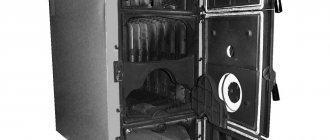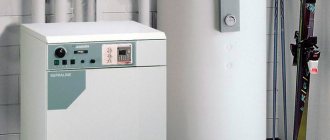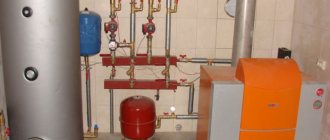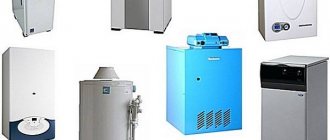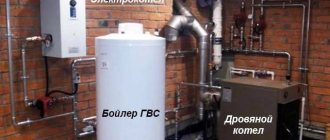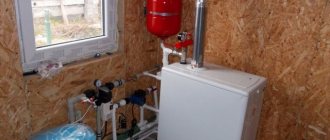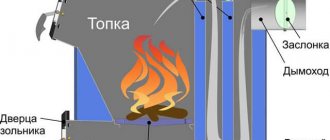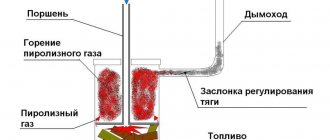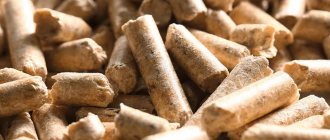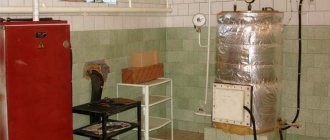Oil evaporation technology
In furnaces of this type, it is not the oil that burns, but its vapor. That is, the waste material is heated up before combustion begins, it begins to evaporate, and the vapors are already ignited. This technology allows dirty, heavy, poorly burning fuel to be decomposed into “lighter” components, and then burned. It is this that, with correctly selected parameters, allows you to achieve virtually smokeless and complete combustion of fuel, in which there are practically no emissions: everything burns.
Do-it-yourself boiler for testing: the principle of a boiler based on oil evaporation
The simplest and most effective way to implement this technology is to use a hot bowl into which waste material drips.
When it comes into contact with hot metal, the oil suddenly evaporates, the vapor mixes with the air supplied here, flares up and burns. The amount of heat generated during this process is large. To achieve maximum efficiency and complete combustion, the burning mixture must remain in the combustion chamber for a long time. Therefore, a stationary impeller must be installed at the mouth of the air duct, which will create the required turbulence in the combustion chamber.
A do-it-yourself steam boiler for testing can be implemented in this form
Despite the high efficiency and “omnivorous” nature, this operating principle is rarely implemented in factory boilers produced in the USA and Europe. But Russian manufacturers produce test boilers that use evaporation technology. The main stumbling block in the implementation of such boilers is the method of preheating the bowl. Those who make these boilers on their own do it simply: throw a wick soaked in gasoline into the bowl, pour in a little diesel fuel or the same gasoline, set it on fire, waiting until the bowl warms up to the required temperatures. After this, the oil supply is opened.
In Europe and the USA, such a solution is unacceptable: it is unsafe. But our manufacturers also use this particular method of igniting their stoves.
Another option for a furnace with a plasma bowl
The video demonstrates one of the options for heating a garage using a working furnace. But this option does not implement a drip supply of fuel: it flows in a trickle and does not burn completely
It is for this reason that the author of the project paid such attention to the insulation and sealing of all removable parts: to minimize the entry of smoke into the room and made a high chimney for better draft
Kerosene heaters
Kerosene is an oily, transparent, flammable liquid, colorless or with a yellowish tint, produced from petroleum. Without going into details of the physical characteristics, the potential of this substance can be judged at least by such areas of application as fuel (or its component) for rocket and gas turbine aircraft engines, as well as glass and porcelain firing furnaces.
In everyday life, kerosene is the most common energy carrier of all types of liquid fuel, as it is used in heating units operated in residential, utility, utility and industrial premises. The higher the purification class of this fuel, the less combustion products are released into the air when using the heater.
Several brands of aviation fuel (TS-1, T-1, T-2, T-1S) and lighting kerosene (KO-20, KO-22, KO-25, KO-30) are used to fill household heaters.
The main brands of kerosene used for household heaters
The characteristics of aviation fuel are high, but its price does not allow this composition to be classified as a combustible material widely available to consumers, so lighting kerosene is mainly used in home heaters.
Operating principle and design of household kerosene heaters
Kerosene heaters are heat generators that heat a room using infrared radiation. IR rays do not affect the transit medium - air, but when they encounter obstacles along the path of propagation, they increase the intensity of the movement of molecules on their surfaces, which causes an increase in the temperature of the upper layers of objects. The interior, which is heated in this way, then gives off heat to the air, initiating convective currents in it.
Operating principle of infrared radiation
Conventionally, a kerosene heater consists of a housing in which the following components are located:
- fuel tank (removable or as part of the structure);
- electric ignition device (optional);
- wick with emitter and combustion intensity regulator;
- protective grille.
Kerosene from the fuel tank flows to the wick, where it burns and heats the metal mesh emitter. The intensity of combustion is regulated by a device that changes the length of the burning wick. To prevent burns from accidental contact, the infrared emitter is covered with a protective grille. There is a valve on the fuel tank lid for replacement air supply, and on the heater body there is a fuel level indicator and a unit shutdown device. For ease of movement, the heaters are equipped with folding handles or special grooves.
Depending on the design and performance class, heaters differ in functionality and, accordingly, price.
Types of kerosene heaters
Infrared kerosene heaters are manufactured in rectangular or cylindrical housings, the dimensions of which are directly proportional to their power.
Types of infrared heaters using kerosene
Rectangular devices, as a rule, are more powerful than cylindrical devices and are manufactured in the form of a unit, in the body of which, behind the emitter on one side, there is a reflective screen that concentrates IR radiation in the opposite direction. The heating direction of such units is adjusted manually by turning the heater in the desired direction.
The most powerful kerosene heaters with rectangular bodies are available in the form of a floor-mounted fireplace with a removable fuel tank and a battery-powered electric ignition function.
Kerosene infrared heaters in the form of fireplaces
Cylindrical heaters are produced in two types - directional and all-round heating. This line of kerosene heaters consists of units that are more compact due to the geometry of the housing. In addition, some models of cylindrical devices are used not only for heating, but also for lighting, reminiscent of the effect of performing this function as a gas lamp.
Cylindrical infrared liquid fuel heaters: on the left - with a built-in fan, universal (kerosene, diesel fuel), on the right - kerosene circular action
Let's look at the characteristics of kerosene heaters using the example of specific units.
Heater "Kerona" (Kerona WKH-3450)
Characteristics:
- power - 3.8 kW
- dimensions - 50.6 × 32.5 × 32.5 cm (height x width x depth);
- consumed fuel - aviation or lighting kerosene;
- energy consumption - 360 g/hour
- Fuel tank capacity - 4.8 l
- heating area - up to 20 m2
- electric ignition of the wick device;
- device for switching off the device when tipping over;
- unit weight - 12 kg;
- manufacturer - Republic of Korea.
Infrared heating unit Kerona WKH-3450
The model is one of the most popular, due to its versatility - the ability to be used for heating both residential and warehouse, utility and utility rooms.
For use in residential premises, it is advisable to first light a kerosene heater outside the home, and let it work there for the first 5-7 minutes until soot formation stops, and then bring it into the room. However, ignition is also possible in the apartment - followed by 5-minute ventilation
Important! Fuel combustion in a heater occurs with the consumption of oxygen from the air in the room, so the heated room must be periodically ventilated - regardless of the degree of presence of the smell from burning kerosene in the home.
Schematic representation of the kerosene IR heater “Kerona” model WKH-3450.
Operating principle of the heater:
- the fuel tank is equipped with a push-action valve at the bottom, which opens when the container is installed in its regular place in the housing;
- fuel from the tank is supplied to the base of the porous wick and impregnates it by capillary method;
- after ignition of the wick, the combustion chamber is heated, causing the subsequent evaporation of kerosene and combustion of its vapors;
- The mesh walls of the combustion chamber heat up to a high temperature and begin to generate infrared radiation.
Important! After heating the combustion chamber, manual adjustment of the wick operation is performed, which determines the calorific value of the heater, the intensity of consumption and the completeness of fuel combustion.
Visual method for determining the efficiency of the combustion process
Advantages of infrared kerosene household fireplace heaters:
- mobility;
- autonomy (batteries);
- durability, including the wick;
- short duration of smoke formation (on/off);
- aesthetics.
Flaws:
- relatively high cost of heaters (from 9 thousand rubles);
- high cost of fuel;
- open fire factors (fire hazard, oxygen consumption from indoor air).
To get a more complete understanding of this kerosene heater, watch the video:
IR kerosene heater FUJIX M168
An economical portable device, a kind of “burner” for heating and cooking, with a body shape reminiscent of a kerosene lamp for outdoor lighting.
Characteristics:
- ignition type – electronic;
- automatic – standard adjustable thermostat;
- rollover shutdown system;
- body material – metal/glass;
- fuel/consumption – kerosene/≈ 0.25 l/hour;
- tank capacity – 2.5 l;
- calorific value – 2-2.5 kW;
- operating time on one gas station -10 -12 hours;
- dimensions - 33x33x44 cm; weight – 4.7 kg;
- country of origin: China.
IR heater FUJIX M168 in reality, specification of components and control devices
This kerosene heater is compact, easy to move and therefore convenient for a garage, small greenhouse, country house. The device can be used as a heater for a tent, provided there is sufficient area and regular ventilation.
A video comparing Chinese and Korean products will help you better navigate your purchase:
Line of liquid fuel heaters:
- "KO - 1.8 Mini";
- “KO – 1.8 Caprice”;
- “Software – 2.5 Mini”;
- “Software – 2.5 Mini+”;
- "PO - 2.5 Savo".
The listed heat generators also belong to infrared heaters, and can run on kerosene or diesel fuel. The models differ from each other not only in power and fuel consumption, but also structurally - in the profile of the firebox, its material of manufacture, and the configuration of the reflector.
Let's look at their most popular modifications.
“KO – 1.8 Mini” is a miniature liquid fuel heater with the ability to cook food.
The firebox, located in a ceramic cylinder, is designed for heating on three sides and for placing dishes on top.
Characteristics of "KO - 1.8 Mini":
- calorific power on the burner - 1.8 kW;
- liquid fuel consumption - 0.2 l/hour;
- tank capacity - 2.5 l;
- operating time at one gas station - 18 hours;
- dimensions – 30x30x30 cm;
- weight - 4.3 kg.
Infrared heater on kerosene or diesel fuel “PO - 2.5 Savo”
In the line of Solarogaz heaters, the unit is distinguished by a steel cylinder around the hearth and a reflector surrounding the firebox on three sides. The upper part of the grid is designed to accommodate cooking utensils.
With dimensions of 37x42x32 cm, the device weighs 5.6 kg.
The calorific value of such a stove is 2.5 kW with an average fuel consumption of 0.2 l/h. The capacity of the fuel tank is 3.2 liters, which is enough for 14-18 hours of continuous operation of the heater.
The liquid fuel stove "PO - 2.5 Savo" is effective for heating apartments, small country houses and country houses, but the power of the units used in the buildings must correspond to the area of the heated premises, and the open fire of the furnace of the units requires periodic ventilation of the rooms. The device copes even better with heating a garage, small greenhouses, and heating and cooking food.
Operating rules
- For fire safety purposes, liquid fuel heaters must be located on a stable base, strictly horizontally and at a safe distance from the interior elements of the room.
Safe placement of an oil heater in a room - Refueling of the fuel tank is carried out only with the heater turned off or in another room - away from sources of fire. At the end of refueling, the tank lid must be tightly closed.
- Fuel storage should be carried out only in specially designated places that meet fire safety requirements.
- When switching from one type of liquid fuel to another, it is necessary to drain the remaining fuel from the tank, which is planned to be abandoned.
- A specific smell when the heater is first ignited is not a sign of a malfunction of the device - it is the preservative compounds burning out.
- It is prohibited to use liquid fuel heaters in children's rooms, cabins and interiors of motor vehicles, vans and trailers while driving, boats, poorly ventilated areas and basements.
- It is not allowed to independently change the design of the heater.
Liquid fuel boiler
In principle, a liquid fuel boiler (or several twin boilers) can be used as a boiler station, but then it is more profitable to heat it with fuel oil, because with the same consumption of fuel oil and gas, the specific heat released for gaseous fuel is much less. There is, however, one flaw in such heating devices, which does not spoil the overall picture, but makes you think about the fundamental installation. We are now talking about ignition (start of operation), which is the basis for the operation of the boiler and the beginning of the heating season. It is no secret that any hydrocarbon is ultimately a flammable material (some require appropriate processing), but, unlike gasoline, oil and diesel fuel begin the combustion process at higher temperatures (this can be seen if you try to light a few drops of gasoline with a match and fuel oil).
Liquid fuel boiler design
That is, all other things being equal, heavier hydrocarbons have a higher combustion temperature, from which we can conclude that the design of a liquid fuel boiler must have a igniter that has a long burning duration and heat-resistant heat exchanger elements. Diesel fuel, fuel oil and oil provide stable and long-lasting combustion provided that fuel is systematically added to the combustion chamber.
The simplest device for a liquid fuel boiler
The easiest option for understanding and describing the properties of these types of boilers is a do-it-yourself stove with a dripper. The firebox, standard for stoves, has a door for kindling with ordinary firewood, and at the top there is a steel dropper through which the fuel enters directly into the combustion chamber. To ignite the unit, you need to light it like a regular oven, let it heat up, and then open the dripper to a minimum. Adjusting the dosage of liquid fuel automatically increases or decreases the combustion temperature, and the combustion force (intensity) is regulated by the blower (supply ventilation). The smaller the volume of incoming air, the weaker the combustion, the safer the fuel and the more stable the heating temperature.
Heating using liquid fuel can only be organized with an uninterrupted supply of fuel, therefore it is not recommended to turn off liquid fuel boilers for a short time (only in the summer). Creating conditions for the correct supply of flammable liquid and timely replenishment of the supply in the tank creates another nuance - a characteristic smell.
Advantages and disadvantages
Among the qualitative and technical indicators there are no clear minuses or pluses, since some, at first glance, negative features may be used for the sake of expanding the list of positive aspects. Everything has already been discussed in the article, but it would not be amiss to recall and classify all the nuances.
So, the pros:
- autonomy (in this case we should talk about isolation from engineering systems and electricity);
- depending on what kind of fuel can be used: if only one type is a minus, and if the boiler is represented by a combined system, this is a plus;
- stable combustion and maintaining an even temperature (provided the dosage is the same, maintaining combustion, even in wind or precipitation, is not difficult).
As 100% minuses, we note:
- heavy heating of fuel to achieve ignition temperature;
- no pauses in heater operation (unjustified fuel consumption);
- regulated minimum temperature in the system (each has its own and depends on the volume of coolant, the size of the combustion chamber and the density of the hydraulic piping).
DIY waste oil boiler (video)
https://youtube.com/watch?v=E22zPchFpzk
Choosing a boiler
How to choose a boiler that runs on liquid fuel so that you are completely satisfied with it? Step-by-step instructions will help you do this.
Step 1. Assess how much money you have. This will significantly narrow the search for the ideal heating boiler model.
Assess your capabilities first
Step 2. Decide what type of boiler you need - single-circuit or double-circuit. You can read about the advantages and necessity of installing one or another type above. However, the cheaper option will most likely be a single-circuit boiler.
Decide on the number of circuits
Step 3. Choose which material suits you best - cast iron or steel. Experts recommend purchasing boilers made of cast iron, as they are more reliable and retain heat better.
Decide on the material
Liquid fuel boiler Sime Rondo
Step 4. If in the future you plan to switch your heating system to gas, then be sure to take this into account when choosing a model and perhaps a heating convector will suit you. The fact is that some of the boilers are quite easy to convert, and then buy just such a boiler.
Basic design of the burner
Step 5. Estimate how much money will be spent on heating the boiler. Each type of device and each of its models require different amounts of fuel. And to make it easier to decide, calculate which boiler is suitable for you in terms of power. To do this, make a simple thermal calculation. At the same time, take into account the number of doors and windows, the thickness of the walls and ceilings of the house, its dimensions, as well as the number of people living there. For example: in a house where the ceiling height is 3 m and the walls are well insulated, about 1 kW is needed for every 10 m2 of area. Boiler sellers usually help make the calculations. You can read what an electric convector is in our article.
Fuel consumption, in turn, depends on power. Take the following diesel fuel consumption per hour: multiply the burner power by a factor equal to 0.1. Calculate oil consumption as follows: multiply 1 liter by 100 m2.
Table of main boiler calculation options
Step 6. Remember that you need to equip fuel storage as well. Also think about what fuel you would like to purchase the unit with. Remember: it is easier to convert a diesel generator into a gas one.
Step 7: Be sure to read reviews about different types and models of devices before making a purchase. Often buyers try to sell not the best, but expensive equipment. Tips and recommendations online can help you avoid mistakes.
Liquid fuel boilers
Device running on fuel oil
Due to the special operation of the burner, a diesel boiler will not operate on fuel oil or waste oil. Additional burners for upgrading a diesel boiler are very expensive, but it is not a fact that after changing the configuration of the unit yourself, it will work stably.
An oil-fired boiler has the following advantages:
- incredibly high thermal conductivity;
- low rate of ash generation in the device;
- luminous flame, promoting the occurrence of radiation heat exchange in the firebox;
- can be used in both large and small boilers;
- extraction and storage of fuel oil;
- high price when purchasing “clean” fuel oil;
- high pour point +25-30 o C.
Purchasing this type of boiler is only beneficial if there is sufficient fuel available at all times. Otherwise, the unit will be expensive and will not pay for itself at all. Oil boilers are primarily used in places where this fuel is processed or created by hand.
Advantages and disadvantages
The main advantage of a diesel fuel boiler is that its use is possible in the absence of all energy sources. The exception is electricity, which is still needed a little, approximately up to 100 W/h. Other advantages of liquid fuel boilers are:
- High efficiency indicator, the efficiency of the units is in the range of 90-97%.
- Lack of inertia when switched off, which will protect the coolant from overheating.
- A high level of automation (in foreign units), thanks to which it is possible to organize weather-dependent control of home heating.
- Possibility of switching to natural gas by replacing the burner.
- Small overall dimensions allow the heater to be installed in a small room.
Liquid fuel boiler using diesel fuel
A widespread type of liquid fuel units is diesel fuel. They are low cost, high efficiency and easy to use. House heating units using liquid fuel - diesel fuel - do not require special permission for installation in a local heating network. You can modify them with your own hands: connect them to the gas main.
The diesel heating unit has a design that includes:
- diesel burner;
- fuel filters;
- pump;
- separate control panel for the automated system;
- safety sensors to maintain stable combustion and the required coolant temperature in the system.
- The fuel is mixed with air in an inflatable burner.
- Mixed with air, it passes into the combustion chamber thanks to a powerful fan, where it burns.
- The coolant heats up, as do the walls of the chamber in which it is located.
- The gases formed during operation leave the device system through a special chimney provided by the design.
Due to the fact that a diesel boiler is not much different from a gas boiler. and it is possible to reconfigure it yourself, since the key difference is the type of burner. But modifying them with your own hands is only possible for diesel boilers with a mounted burner. This trick won't work with the built-in one.
Re-equipping the firebox with your own hands using the parts included with the boiler should only be done according to the proposed drawings and nothing else.
calculate the fuel consumption of the device and its heating output
This is easy to do thanks to the formula: boiler power in kW/10 = kg of fuel per 1 hour of operation. For a region with average climatic conditions, 3 tons of solarium will be needed to supply a building with an area of 300 m2 with coolant. On average, 0.1 l/hour per 1 kW of device power. Consumption may vary depending on the temperature needs of residents - if someone feels comfortable at a temperature of 22-24 o C, then for others the optimal temperature will be from 25 o C. And the higher the temperature, the greater the fuel consumption.
Briefly about the advantages and disadvantages of liquid fuel heating equipment
So, if heating is required “here and now”, and there is no way to gain access to network gas or organize a constant supply of liquefied gas, then we consider options for boilers using wood or other types of solid fuel, electric heating or the use of equipment running on liquid hydrocarbons . What makes the latter stand out for the better?
The advantages include the following:
- Installing a liquid fuel boiler does not require very lengthy and “tedious” conciliation procedures with the collection of documents, drawing up and approval of the project by authorities. This can be considered its distinctive advantage from gas equipment - the owners carry out the installation “at their own peril and risk.” True, fire safety measures here are even stricter, so there may be friction, if not with the gas workers, then with the fire inspectorate.
- The advantage over solid fuel boilers is the ease of precise adjustments and the absence of the need for frequent intervention in the operation of the boiler room. There is no need to regularly load firewood or coal, which even long-burning boilers cannot do without.
- Compared to electric boilers, liquid fuel boilers are less dependent on the vagaries of electrical networks. Most of them still cannot be called non-volatile - the circuit contains fans for pumping air, pumps for providing fuel supply and, often, electronic control units. However, this problem, in case of possible temporary interruptions, can be solved by installing an uninterruptible power supply unit or a backup generator; under the same conditions, electric boilers or other electric heaters become completely inoperable.
In addition, for all-electric heating to work, it is often necessary to increase the power at the entrance to the house, that is, install new or additional lines, which can become very expensive. Liquid fuel boilers will not require such measures, but they have their own “tricks”.
- Liquid fuel equipment generally has a very decent efficiency, comparable to that of gas units and even electrical installations or appliances. This is especially true for modern models in which additional heat extraction is organized due to the condensation of water vapor, which is always formed in considerable quantities during the combustion of any hydrocarbons, both gaseous and liquid.
- Most boilers operating on liquid fuel are highly versatile. In fact, their combustion chamber is multifunctional, and allows you to change burners depending on the type of fuel used - be it kerosene, diesel fuel, waste, biofuel, etc. Moreover, practically without any serious alterations, the boiler can eventually become a gas boiler - again, only by changing the burner. Thus, if in the foreseeable future it is still planned to lay a gas main to the house, that is, it is necessary to wait a couple of years, then a boiler of this type simply becomes a “lifesaver.” There is no need to purchase and reinstall a new unit, or change its water piping - just select and install a gas burner with a unified mounting flange assembly. By the way, there are also multi-fuel burners, for example: gas and light types of liquid fuel (diesel fuel).
A special advantage of boilers of this design: they can easily be converted to a different type of fuel by changing the burner or using a universal (multi-fuel) class burner.
To develop the topic, we can add that such burners for gaseous or liquid fuels, standardized in terms of mounting, are often suitable for certain lines of wood-burning boilers.
Boiler prices
liquid fuel boiler
The boiler is the same, solid fuel “Wirbel Eko-SK”, but by installing the appropriate burner and the necessary automation it turns into a gas, diesel or pellet boiler
However, not everything is so “rosy” with liquid fuel boilers. Their disadvantages
- First of all, the cost of high-quality diesel fuel cannot be called low. And the consumption when heating a house is large, and taking into account the length of the heating season in our area, it turns out to be considerable. That is, the annual heating costs will not be affordable for everyone.
- It is necessary to create conditions for storing large volumes of fuel. If we add here its fire hazard, the task looks even more difficult. In addition, at low temperatures, diesel fuel in the pipelines, and even in the tank itself, can begin to thicken and be “caught” by frost, which means that it is necessary to thermally insulate the storage facility and the line from it to the boiler. Therefore, very often they try to place fuel tanks directly in the boiler room, which will require a considerable amount of space (taking into account the quite “impressive” dimensions of the boiler itself).
Nowadays, there are no problems with purchasing capacious and fairly compact containers for diesel fuel, but still this “colossus” needs to be attached somewhere, and it is not cheap.
- Petroleum products always have a specific smell, and no one wants to poison the atmosphere in their rooms with them. Therefore, there can be no talk of placing equipment in a residential area or in adjacent rooms that do not have sealed partitions or doors. It turns out that the optimal solution would be to build a dedicated boiler room.
- Another circumstance leads to a similar conclusion - the operation of liquid fuel heating equipment is usually very noisy.
- Unlike gas, petroleum products, when burned, emit a considerable amount of soot and fine soot, which quickly begins to clog the boiler heat exchangers and chimney system. Therefore, preventive maintenance work on cleaning the boiler will have to be carried out much more often.
- Liquid fuel most often requires pre-cleaning (filtration) and heating. This complicates the design of the boiler and often requires additional costs for replacement filter elements.
- It is believed that it makes no sense to purchase a boiler that runs on liquid fuel to heat a small (say, up to 100 m²) house. It would be wiser to look for another acceptable solution.
- The cost of boilers of this type or replacement burners for them is very high.
Liquid fuel boilers: review of models and selection of the best
This series of models is produced by De Dietrich (France). The boilers are made of cast iron and have a power from 21 to 39 kW. They can be provided with one of three systems for adjusting the operation of the installation (the buyer can choose) - manual, remote, automatic adjustment. It is possible to convert to gas with the condition of replacing the burner. The model costs approximately 71,200 rubles.
Delta Pro 25/45/55
Manufacturer – Belgium (ACV). The purpose of these installations is home use, mainly not only for heating, but also to provide the residents of the house with hot water - a tank for heating water is connected to the heating circuit. The liquid is heated to +30 degrees in approximately 10 minutes. The boiler can be converted to use gas fuel. Cost - from 160,000 to 202,000 rubles.
Kiturami STS Oil
South Korean boilers are in great demand due to their low price (from 28,920 rubles). But at the same time they are of excellent quality. They are made of stainless steel, light and durable, and also compact.
Bison 30NL/40NL/50NL
Manufacturer – Slovakia (Protherm company). This range of models combines several units that work perfectly on liquid fuel. They differ in power, which directly depends on the number of cast iron sections in the heat exchanger. A viewing window helps monitor the operation of the equipment. The units also provide water heating. Interestingly, the manufacturer names the boilers after animals. The equipment can be converted to consume gas fuel - the burner is purchased separately. Cost: 46,100 – 74,600 rubles.
These Korean boilers last at least 10 years, according to the manufacturer. Their power starts from 11 kW. The units are equipped with a turbocharged burner built inside. Due to this, noise reduction was achieved. Boilers of higher power (from 40 kW) are equipped with a burner with gear pumps. The boiler will cost from 38,580 to 49,850 rubles (depending on the specific modification).
The manufacturer of these boilers is Germany (Buderus). They work well on liquid fuel and can be easily converted to gas if necessary. They are distinguished by reliability, efficiency, and safety. Very economical - this was achieved due to a unique control system that monitors weather conditions and is called Buderus Logamatic
And, what is also very important, the boilers of this company look very presentable. Average market price - about 125,580 rubles
Popular models
To make the right choice and finally buy a heating boiler, you should take a closer look at the main models. It is those described below that are most often installed in houses for the purpose of heating them.
Choosing a manufacturer
Boilers from the following companies are usually purchased:
- Ferroli (Italy):
- Protherm (Slovakia);
- De Dietrich (France);
- Kiturami (South Korea);
- Buderus (Germany).
Table. Popular models of liquid fuel boilers.
Attention: The internal data of table “108” is corrupted!
Video - Selection of a diesel boiler
Device and principle of operation
As mentioned above, liquid fuel heating boilers are structurally similar to two-pass and three-pass gas boilers. Due to their design, the products are produced in a floor-standing design.
For reference. In boiler installations with a fire tube heat exchanger, combustion products can change the direction of movement several times, making several passes through the fire tubes and intensively transferring heat to the water jacket. Based on the number of strokes, the heat exchanger is assigned a characteristic - three-pass or two-pass.
The similarity lies in the design of the heat exchanger from flame tubes enclosed in a water jacket. In the very center there is a fuel combustion chamber; only in a diesel unit it has a cylindrical shape. This is due to the design features of the burner device using liquid fuel. The main elements and details are shown in the figure.
device of a Viessmann boiler operating on liquid fuel
A – external thermal insulation shell; B – heat exchange surfaces of flame tubes; C – combustion chamber; D – electronic control unit; E – burner device.
In products from leading foreign manufacturers, the firebox is made of heat-resistant stainless steel; budget domestic heat generators can also be made of ordinary thick metal. The heat exchanger material is cast iron or steel; basalt fiber or dense polyurethane foam is used for thermal insulation. A burner that runs on liquid fuel is of particular interest; its design with a breakdown of the elements is shown below.
Diesel burner drawing
A – air control throttle valve; D – ignition system unit with flame control sensor; E – fuel line; F – fan electric motor; G – pump; K, N – supply and return pipelines for fuel; I – solenoid valve; L – fault signal reset button; M – automatic heating control; N – console; O – ignition cable; P – electrodes of the ignition system; R – cylindrical working part; S – mixing device; T – nozzle; U – rod with fuel heater; V – air intake device; W – burner body; X – air channel; Y – fan impeller.
The working part is made in the form of a cylinder with many holes, through which a flame passes. When fuel combustion occurs, the burner flame heats the cylindrical walls of the firebox, as shown in the photo.
Diesel burner operation
A special container is designed for fuel; it can be free-standing or suspended from the wall; a supply line is laid from it to the burner. Some burner devices have a return fuel line to relieve pressure, then the installation of the boiler and its connection are provided by two pipes - supply and return, going into the fuel container. Ignition is carried out automatically at the command of the control unit.
Device Features
What is a heating boiler that runs on liquid fuel? This is a special device, safe and technologically advanced when used correctly, which, by processing liquid fuels (in other words, burning), turns them into heat, which heats the entire residential building. At the same time, they cope with their task perfectly - it’s not for nothing that owners of private houses praise them.
Liquid fuel boiler
We also note that liquid fuel heating boilers not only heat living quarters, but also heat water (however, this depends on the heating system as a whole and on the type of device). Using these boilers is very convenient and comfortable, since they are fully automated - the owner only needs to top up the fuel in a timely manner.
On a note! As you know, there are not only liquid fuel boilers - there are devices that run on solid fuel, gas, and electricity. They differ from each other in the type of raw materials used for work. A liquid fuel unit also differs from a gas unit in that it has some design features - it has a special burner-fan built into it.
Boiler design diagram
Unfortunately, even those who initially use a liquid fuel device often do not know by what principle this heat generator is capable of heating an entire house. First of all, it is worth saying that the above-mentioned fan burner forces the fuel to enter the chamber, where it is burned and heat is released. The burner is also responsible for the safety and high productivity of the device - the fuel is atomized during supply, mixed with clean air, and only then does ignition occur.
You may be interested in information—boiler room diagram
Another important part of an oil-fuel boiler is the heat exchanger and coolant. During the ignition of the fuel in the chamber, the released heat completely envelops the heat exchanger, heating it, and due to the heating of this part, thermal energy is transferred forward to the coolant. The exhaust itself (“exhaust”) exits through the chimney into the street.
The next important element of the heating boiler is the heat exchanger, which is made of steel or cast iron
Thermagent Eko coolant
This entire system is enclosed in a durable housing that is thermally insulated. And automation monitors the ongoing process - everything works almost without human intervention.
Liquid fuel boiler Viessmann Vitorondens 222-F
How to make a liquid fuel boiler with your own hands
What you will need during the work process:
- welding machine;
- angle grinder (grinder);
- metal barrel with a volume of 200 l;
- scraps of reinforcement (W 15 mm and length from 3 cm).
If there is no barrel of a suitable size, you can make it yourself, from sheet metal; for this you will need pipes with a diameter of at least 5 cm and a length of 80 - 100 cm. An all-metal circle with a thickness of 4 mm or more can be used as the bottom.
- Inside the barrel, it is necessary to weld three supports parallel to the ground: the first will be needed for installing the furnace itself, the second at the level of the blower door in the boiler, and the third 20 cm above the pipe.
- To make grates (a cast iron grate through which air penetrates under the fuel), it is necessary to make a metal circle with slots, the thicker it is, the better. The grate partition is located inside the boiler.
- In the boiler lid, which, like the grates, must be made of a thick metal circle, a hole is made for attaching the chimney pipe.
- In order to get a hole for the stove doors, you will need to make a slot in the bottom of the structure; the door should be slightly larger than the hole. Also, inside the box it is necessary to make a partition; it will separate the ash and combustion compartments.
Risk factors, maintenance tips
Like any other device, an oil-fuel boiler is a potential source of danger - smoke, fires, etc., however, following these recommendations will help minimize the risks:
- be sure to comply with all fire safety requirements;
- install the boiler at some distance from the wall (at least 100 cm to the front surface of the unit);
- do not leave flammable materials and objects in the room where the equipment is installed;
- make sure there is a system that will block the device in the event of a fuel leak;
- equip ventilation in the boiler room, and also take care of the correct chimney;
- Be sure to follow all recommendations specified in the operating instructions.
Liquid fuel boiler maintenance
The boiler should be cleaned regularly. The fact is that the soot layer, which is about 2 mm thick, increases fuel consumption by as much as 10%. It is necessary to clean the nozzles in the burner that injects liquid fuel. Check the boiler at least once a year. It is best to invite an experienced specialist to carry out preventive work.
The oil boiler needs regular cleaning
Remember that timely maintenance of a liquid fuel boiler will ensure its long and reliable service without interruptions. Therefore, you should not neglect cleaning - it will cost much less than buying a new boiler. And absolutely all models of installations need cleaning, regardless of price and quality.
Classification
Depending on the capabilities of water heating, diesel fuel heating boilers are divided into
- single-circuit, which are not intended for heating water;
- double-circuit with heating element or storage boiler.
Diesel boilers can have natural draft, when gases are removed through a chimney, or forced draft.
Forced draft is provided by blower fans and requires the installation of a coaxial chimney (it is built on the principle of “pipe in pipe” - combustion products are discharged through the inner pipe, and combustion air through the outer one).
A special feature of oil boilers is the presence of an oil heating system.
Almost all modern models have automatic control, a built-in thermostat, operation control sensors, and forced removal of combustion products.
Features of liquid fuel boilers
Advantages
Liquid fuel heating, like any other, has certain advantages and disadvantages.
Among the positive aspects are the following:
- To use the device, you do not need to obtain permission, since this equipment is classified as a household appliance.
- Do-it-yourself installation is possible, since there is no need to install a gas pipeline.
- The equipment has high efficiency, which reaches 95 percent.
- Low level of air pollution - all combustible products meet environmental standards.
- Simple operating instructions, since almost all modern devices are equipped with automation. For the same reason, boilers can operate for a long time without human intervention.
- As mentioned above, the possibility of conversion to run on gas.
As we can see, the equipment has many advantages and is quite versatile.
Liquid fuel boiler with tank
Flaws
Among the disadvantages of the boilers under consideration, the following points can be highlighted:
- High fuel consumption. Therefore, this type of heating is quite expensive.
- The boiler, together with the fuel container, takes up quite a lot of space.
- The need to monitor the operation of the system and add fuel to the tank from time to time.
- The room must be equipped with an exhaust hood to remove combustion products.
- During operation, the equipment makes quite a lot of noise.
- The equipment requires power supply, as the operation of the device is controlled by electronics. Therefore, to operate in autonomous mode, it is necessary to use an independent power supply.
- It is necessary to use a special container for fuel, otherwise an unpleasant smell of fuel will spread inside the room.
Note! Liquid fuel boilers, unlike other analogues, require proper maintenance. In particular, soot should not be allowed to accumulate on the walls of the device, as this will complicate the working process of the device.
As a result of these shortcomings, you should consider the pros and cons, and also become familiar with the features of electric and solid fuel boilers. For example, if you need a device for a summer residence where there is a forest nearby, it is more advisable to purchase a solid fuel boiler. In this case, heating may be completely free.
Liquid fuel double-circuit boiler ACV
